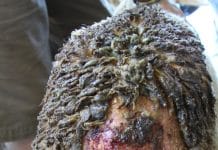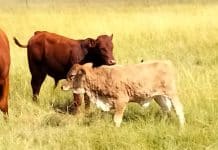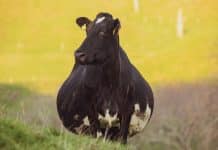This article is part of a series of articles educating livestock owners and farmers about the importance and effect of the Animal Diseases Act, 1984 (Act 35 of 1984). It explains the reasons for the existence of this Act, what farmers’ general rights and duties are, and goes into more detail regarding the control measures for some of the most important controlled animal diseases.
Part 4: Control of sheep scab
As with anthrax, sheep scab has a very long history. In fact, it is one of the oldest known diseases that affects sheep. In South Africa it became a regulated disease in 1693, when Simon van der Stel promulgated regulations to prevent its spread.
Sheep scab spreads very easily and causes severe distress in animals. It has a significant economic impact on sheep farmers due to international trade implications (especially for the wool industry), loss of body condition, production losses, and the cost of treatment.
The cause of sheep scab
Sheep scab is caused by the Psorpotes ovis mite. Even though the mite is sometimes visible to the naked eye, it can only be properly seen and identified using a microscope. The mites feed on the skin of animals, causing an intense inflammatory reaction coupled with severe itching. This causes sheep to scratch and bite themselves, leading to hair and wool loss as well as self-trauma. In extreme cases it can even cause mortalities.
The mites have a life cycle of approximately two weeks (from hatching to laying eggs). They can survive in the environment for up to three weeks without feeding on the host. It is an important aspect to keep in mind when treating infected sheep and managing the spread of the disease.

Control measures: Routine measures for susceptible animals
Regulations stipulate that sheep that are moved to a farmer’s land must be treated twice with an effective remedy before they may be mixed with other sheep on the farm. The required interval between the two treatments is not stipulated in the Regulations. Based on the two-week life cycle of the mites, the second treatment should be administered seven to ten days after the first treatment. This will ensure that any eggs that might still hatch after the first treatment will be killed before the mites can lay eggs again.
Control measures: Suspected outbreaks
The responsible state veterinarian must be notified as soon as possible of any suspected outbreak of sheep scab. It is important to note that it is compulsory, as stipulated by the Regulations, to report any skin condition in sheep that present with one or more of the following symptoms: itching, tangled wool, or bare scabby patches. It is therefore not up to the farmer to diagnose sheep scab in animals; he or she must notify a state veterinarian so a proper diagnosis can be made.
Farmers should also remember their general duty in terms of Section 11 of the Animal Diseases Act, 1984 (Act 35 of 1984), which stipulates that infection in animals as well as the spread of diseases must be prevented. For that reason, they should refrain from moving and transporting any sheep and goats if the animals are suspected of having any skin conditions. Any such animals must be quarantined until a diagnosis has been made.
Contact and infected animals
When there is an outbreak of sheep scab, the State Veterinary Services (SVS) will usually place the farm as well as contact farms under quarantine. The quarantine notices will stipulate the requirements of quarantine. However, even if a farm has not been placed under quarantine, it is required that all infected and contact animals be isolated and treated.
Both sheep and goats are regarded as susceptible to sheep scab, which means that goats need to be treated in the same manner as sheep. Although goats do not exhibit symptoms of the disease, they can be carriers of the mite and can infect sheep.
Infected and contact animals must be treated twice with an effective remedy no less than seven days and no more than ten days apart. A dip or an injectable agent may be used, provided that it is registered in South Africa for the treatment of sheep scab.
Although it is the owner’s duty to treat animals, the SVS may be present to oversee the process. If the SVS cannot be present, the owner may be required in terms of Regulation 18(1)(b), to provide them with the empty treatment containers. They may also be required to provide a sworn declaration confirming the details of the treatment.
Quarantined sheep and goats may not be moved without the consent of the relevant state veterinarian. Such animals may only be moved if the farmer has a Red Cross permit, and only if a sealed vehicle is used and subject to the conditions stipulated on the permit.
In conclusion
The strict control measures for a disease that only affects sheep and cause relatively few mortalities may seem excessive. However, the fact that sheep scab has been cause for concern for centuries, and has not yet been eradicated or sufficiently controlled, is proof that control remains necessary.
It is a highly contagious disease, but if farmers implement the required control measures and administer preventative treatment in problem areas, it can be managed successfully. – Dr Trudie Prinsloo, director of Legalvet Services
Read part one, The Animal Diseases Act: What farmers should know about control of certain diseases by clicking on the link. Part two, The Animal Diseases Act: Foot-and-mouth disease can also be read by clicking on the link. Read part three, the Animal Diseases Act: Control of Anthrax.








